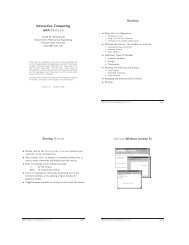"O Soul, Come Back!" A Study in The Changing Conceptions of The ...
"O Soul, Come Back!" A Study in The Changing Conceptions of The ...
"O Soul, Come Back!" A Study in The Changing Conceptions of The ...
You also want an ePaper? Increase the reach of your titles
YUMPU automatically turns print PDFs into web optimized ePapers that Google loves.
368 YING-SHIH YUwhen the function <strong>of</strong> pa<strong>in</strong>t<strong>in</strong>g is clarified.6 Moreover, the lady belowthe moon (fig. 1, b), <strong>in</strong>stead <strong>of</strong> be<strong>in</strong>g the goddess <strong>of</strong> the moon(Ch'ang-eh *M or Heng 0 -), may well have been a representation<strong>of</strong> the departed soul <strong>of</strong> the Countess <strong>of</strong> Tai herself. A comparisonwith the T-shaped silk pa<strong>in</strong>t<strong>in</strong>g from tomb no. 3 shows thatthe most noticeable difference between the two heavenly scenes lies<strong>in</strong> the absence <strong>of</strong> the so-called Ch'ang-o <strong>in</strong> the latter.7 MichaelLoewe has also made an <strong>in</strong>terest<strong>in</strong>g suggestion that the beautifulwoman's figure end<strong>in</strong>g <strong>in</strong> a serpent<strong>in</strong>e tail at the central apex <strong>of</strong> thepa<strong>in</strong>t<strong>in</strong>g (fig. 1, a) may not be <strong>in</strong>tended to represent any <strong>of</strong> themythological figures that scholars have put forth. Instead it mayhave been the artist's <strong>in</strong>tention to represent the f<strong>in</strong>al stage <strong>of</strong> thecountess' journey to heaven when she has reached her dest<strong>in</strong>ation.8In other words, one <strong>of</strong> the two figures must be a representation <strong>of</strong>the countess' hun-soul. It is important to note that <strong>in</strong> the round centralspace <strong>of</strong> the second pa<strong>in</strong>t<strong>in</strong>g, the female figure is replaced by amale figure. This difference <strong>of</strong> gender makes better sense when wetake <strong>in</strong>to consideration the gender <strong>of</strong> its occupant. It is quitereasonable to assume that the male figure <strong>in</strong> this case is also arepresentation <strong>of</strong> the soul <strong>of</strong> the countess' son <strong>in</strong> heaven.9<strong>The</strong> establishment <strong>of</strong> the central theme <strong>of</strong> the T-shaped pa<strong>in</strong>t<strong>in</strong>gsas the summons <strong>of</strong> the soul also helps to identify the function <strong>of</strong> thesilk pa<strong>in</strong>t<strong>in</strong>g. While the suggestion that the pa<strong>in</strong>t<strong>in</strong>g was a bannerused <strong>in</strong> funeral processions cannot be completely ruled out, it ismore likely that it was the burial shroud, hu, frequently referred to<strong>in</strong> Han texts <strong>in</strong> connection with thefu ritual. In the Han <strong>in</strong>ventories<strong>of</strong> funeral furnish<strong>in</strong>gs found <strong>in</strong> both tombs there is an item listed as"fei-i, 12 feet long," which has been identified with the T-shaped6Ch'ang-sha Ma-wang-tui i-hao Han-mu RbJ,'F*-yt if, 2 vols. (Pek<strong>in</strong>g: Wen-wuch'u-pan-she 1973), 1:41 identifies the two men as "the guardians <strong>of</strong> the heavenly gate," andAn Chih-m<strong>in</strong> %,O "Ch'ang-sha hs<strong>in</strong> fa-hsien ti Hsi-Han po-hua shih-t'an" :i'V'*R,(,9, A R, K'ao-ku ~ti (hereafter KK), 1973.1:45-46, identifies them as ta ssu-m<strong>in</strong>gand shao ssu-m<strong>in</strong>g. For a detailed and technical study <strong>of</strong> this pa<strong>in</strong>t<strong>in</strong>g <strong>in</strong> English, see MichaelLoewe, Ways to Paradise, <strong>The</strong> Ch<strong>in</strong>ese Questfor Immortality, (London, Allen and Unw<strong>in</strong>, 1979),chapter two.7Wang Po-m<strong>in</strong>, IE{b "Ma-wang-tui i-hao Han-mu po-hua p<strong>in</strong>g-wu Ch'ang-o penyiieh".:FEi L ff.I,, KK 1979.3:274.8 Loewe, Ways to Paradise, p. 59.9 See Ch<strong>in</strong> Wei-no, eNCZ "T'an Ch'ang-sha Ma-wang-tui san-hao Han-mu po-hua,"A '$'.%iEi Vi ,M, WW 1974. 11:43.















